© Copyright 2020 Foshan Membrane Technology Co., Ltd. All rights reserved. Sitemap
Coronavirus disease 2019 (COVID-19) pandemic that erupted in late 2019 poses a serious threat to human life and health and has profound implications for public health and the global economy. (1,2) COVID-19 is extremely infectious and is mainly caused by respiratory droplets or aerosols from infected people sneezing, coughing, speaking, or breathing, and can be inhaled into the human body through the mouth, nose, and eyes. (1,3,4) It has been found from the research of influenza virus that the aerosols produced by human beings consist of coarse particles (>5 μm) that can settle after being suspended in the air for about 1 h and fine particles (<5 μm) that can be stably suspended in air for a long time in an unventilated indoor environment. Coronavirus, with a diameter of about 150 nm, can remain infectious in fine particle aerosols for at least 16 h. (1,5) In addition, particulate matter (PM) in the atmosphere, especially that with an aerodynamic diameter of less than 2.5 μm, also known as PM2.5, is one of the main causes of haze pollution, which can pass through the human respiratory system and enter the bronchi and lungs, causing serious health problems, such as lung diseases and even cancer. (6−15) COVID-19 and PM2.5 have become a major threat to human life and health.
The use of personal protective equipment (PPE), such as face masks, can effectively prevent the inhalation of COVID-19 and PM2.5 by capturing droplets or aerosols and is an effective way to combat them. (1,16) Generally, air filtration materials are composed of porous membranes and fibrous membranes. (12) The porous membrane contains small pores prepared by stretching or phase-inversion methods on a solid substrate and has a high particle-removal efficiency and large pressure drop because of their small pores and low porosity. (17) Fibrous membranes consist of randomly oriented fibers forming a network structure, including meltblown nonwoven and spunbonded nonwoven, which are ideal candidates for air filters because of their cost effectiveness, energy efficiency, and ease of mass production. (8,18) However, the fiber diameter of these materials is in the micrometer range and the pore size is relatively large, resulting in a low filtration efficiency and reduced pressure drop for capturing fine particles. (7,8,19,20) In order to improve the removal efficiency of fine particles without increasing the pressure drop, electret materials are embedded into meltblown nonwovens to form electret charges on the surface of nonwoven. (21) Electrostatic adsorption significantly improves the removal efficiency of fine particles captured by meltblown nonwoven.
In recent years, nanofiber-based air filtration materials have received increasing attention because of the advantages of the nanoscale fiber diameter, relatively small pore size, high porosity, and large specific surface area, thus resulting in higher filtration efficiency. (15,22) These nanofiber-based air filters generally include five different mechanisms for capturing aerosol particles: inertial impaction, interception, Brownian diffusion, gravity deposition, and electrostatic adsorption. (8,20,23) Electrospinning is a simple and easy-to-operate method for preparing nanofiber-based air filters with an interconnected porous structure, high porosity, a large surface area, and in situ-endowed nanofibers with electrostatic charges. (24−27) However, the stability of electret and electrostatic charge may be affected by the external environment such as temperature and humidity. (28) The electret charge of meltblown nonwovens and the electrostatic charge of electrospinning nanofiber membranes are easily dissipated when stored or operated under high-temperature and high-humidity conditions.
In this work, we proposed a facial and robust fabrication strategy of the ZnO@NF hybrid air filter with a hierarchical structure by coating the mixture of flower-like zinc oxide (ZnO) and PVA-co-PE nanofiber suspension. The PVA-co-PE nanofiber yarns were obtained using the melt extrusion phase separation method invented by our group. The abovementioned nanofiber yarns were dispersed in the mixed aqueous solution using a high-speed mixer to obtain a stable nanofiber suspension. The hierarchically structured ZnO@NF hybrid air filters were prepared by uniformly mixing flower-like ZnO superstructures and PVA-co-PE nanofiber suspension and then coating it on the surface of the PP meltblown nonwoven substrate. The filtration efficiency and pressure drop of the ZnO@NF hybrid air filter increase with the increasing loading amount of the flower-like ZnO superstructures. When large-sized flower-like ZnO superstructures are incorporated into the nanofiber-interconnected network, the pressure drop is significantly reduced, which may be due to the increase in surface roughness, porosity, and specific surface areas. The ZnO@NF hybrid air filters exhibit a much higher filtration efficiency than the PP meltblown nonwoven with electret charges eliminated, solving the possibility of electret charge dissipation. The results show that these ZnO@NF hybrid air filters have great potential in some special areas such as high-temperature and high-humidity environments.
The PVA-co-PE nanofiber yarns are prepared by using the melt extrusion phase separation method. As shown in Figure 1a–e, the basic principle of this method is that two immiscible polymer resins are melted and blended in a twin-screw extruder, where the dispersed phase is to form many microspheres in the continuous phase. Under the combined effect of shear and stretch force, the microspheres are gradually elongated and stretched to form microellipsoids, and then form continuous nanofiber yarns in composite fiber during the extrusion process. After the removal of the continuous phase, the thermoplastic nanofiber yarns are obtained. (29) The morphology of the prepared PVA-co-PE nanofiber yarns is demonstrated in Figure 1f. The diameter and size distribution of PVA-co-PE nanofibers are shown in Figure 1g, and the average diameter calculated from the SEM image is 0.75 ± 0.2 μm.
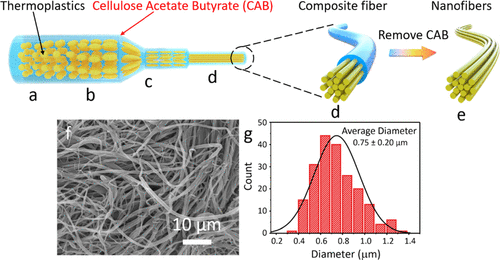
Figure 1. (a–e) Schematic for the mechanism of melt extrusion phase separation to fabricate thermoplastic nanofibers, (f) SEM image of the PVA-co-PE nanofibers and its diameter size and size distribution (g).
The flower-like ZnO superstructures were synthesized by using a template-free and surfactant-free hydrothermal method, and its morphology and schematic diagram are shown in Figure 2a,b. The time evolution of the morphological changes of the flower-like ZnO superstructures is demonstrated in the Supporting Information (Figure S1). In the initial stage, the ZnO crystals form a long octahedral shape. As time goes on, the large ZnO crystals become larger, while the small ZnO crystals become smaller because of Ostwald Ripening. Subsequently, needle-punched structures are formed on the surface of the large-size long octahedral ZnO crystal, and then, small-size flower-like ZnO crystals are formed. The large-size long octahedral ZnO crystals gradually dissolve, and small-size flower-like ZnO crystals gradually grow. Finally, all the large-size long octahedral ZnO crystals disappear, and small-size flower-like ZnO crystals become large-size flower-like ZnO superstructures. It is observed that the large-size flower-like ZnO superstructures are monodisperse, with an average diameter of 4.44 ± 0.70 μm, and the petals are needle-shaped with an average diameter of 289.15 ± 60.32 nm. The element and composition distributions of the synthesized flower-like ZnO superstructures were investigated by energy-dispersive X-ray spectroscopy (EDS) loaded on a scanning electron microscope, as shown in Figure 2c–e. It can be seen from the images that Zn and O elements are uniformly distributed in the flower-like ZnO superstructure. The X-ray diffraction (XRD) system was used to identify the crystal structure of the synthetic flower-like ZnO superstructure. As shown in Figure 2f, the diffraction peaks in the XRD pattern of the synthetic flower-like ZnO superstructure are consistent with the values of the hexagonal wurtzite structure of the ZnO crystal in the standard card (JCPDS No.36-1451). (30−34) The synthetic flower-like ZnO superstructure has sharp diffraction peaks and high intensity, indicating that it is highly crystalline.
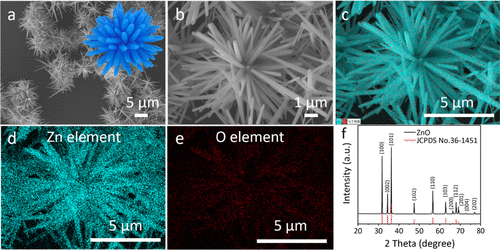
Figure 2. (a) SEM image of the flower-like ZnO superstructure and its schematic diagram in the upper right corner, and its magnified image (b), (c–e) EDS element mapping images of the flower-like ZnO superstructure, and (f) XRD pattern of flower-like ZnO superstructures synthesized at 70 °C for 24 h.
The fabrication process of the ZnO@NF hybrid air filter is illustrated in Figure 3. Two immiscible polymers, such as PVA-co-PE resin and CAB resin, are melt-blended and extruded through a twin-screw extruder to obtain PVA-co-PE/CAB composite fiber. After removing the polymer matrix of the composite fiber (CAB component), PVA-co-PE nanofiber yarns were obtained. The stable PVA-co-PE nanofiber suspension was obtained by dispersing PVA-co-PE nanofiber yarns in an aqueous mixture of isopropanol and deionized water and shearing them into a suspension. The synthetic flower-like ZnO superstructures were mixed with PVA-co-PE nanofiber suspension and then coated on the surface of the PP meltblown nonwoven that removes the electret charge.
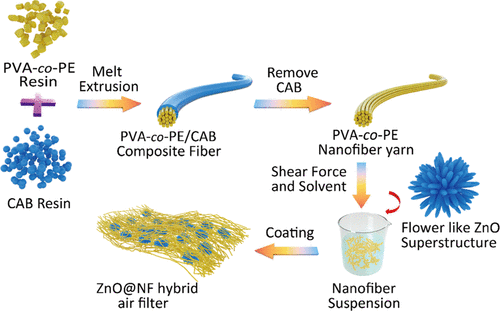
Figure 3. Schematic diagram of the preparation of the ZnO@NF hybrid air filter.
The morphologies of the pure PVA-co-PE nanofiber membrane and the ZnO@NF hybrid air filters are demonstrated in Figure 4. As shown in Figure 4a, the PVA-co-PE nanofibers are randomly arranged and assembled into a nanofiber membrane with an interconnected porous structure. However, nanofibers with a relatively uniform fiber diameter and a single component have a two-dimensional planar structure, which provides limited control over the pore size and the porosity of the membrane. As a result, the PVA-co-PE nanofibers have a high specific surface area, and thus, they tend to self-aggregate and entangle to reduce surface free energy, resulting in high energy consumption as the air filter. The microsized flower-like ZnO superstructures that served as scaffolds were introduced into the PVA-co-PE nanofiber membrane to increase the porosity, specific surface area, and surface roughness, as shown in Figure 4b–d.
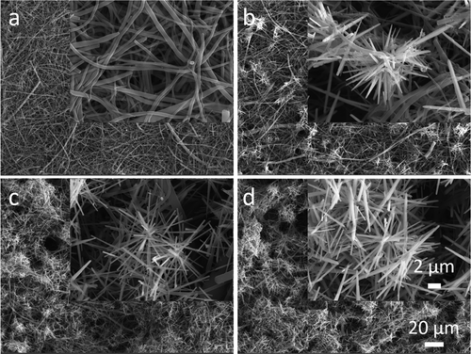
Figure 4. SEM image of the ZnO@NF hybrid air filter with different weight percentages of flower-like ZnO superstructures (a) 0%, (b) 25%, (c) 50%, and (d) 62.5%.
The ZnO@NF hybrid air filters have a high porosity, specific surface area, and surface roughness, which can provide higher fine particle-removal efficiency and lower pressure drop. The filtration performance of the ZnO@NF hybrid air filter, including filtration efficiency, pressure drop, and quality factor, is shown in Figure 5. As shown in Figure 5a, it is observed that the filtration efficiency and the pressure drop of the PP meltblown nonwoven with electret charges removed are 29.76 ± 3.21% and 1.50 ± 0.18 mmH2O, respectively. It can be explained that the low filtration and pressure drop of the PP meltblown nonwoven with eliminated electret charges are because it is made up of randomly oriented microsized fibers, thus resulting in a large pore size. It is calculated from scanning electron microscopy (SEM) images that the average fiber diameter of PP meltblown nonwoven is 1.58 μm, and the pore size is 11.136μm (Figures S2 and S3). The filtration efficiency and pressure drop of the pure PVA-co-PE nanofiber air filter are 89.14 ± 5.21% and 22.77 ± 0.0.36 mmH2O, respectively. The pressure drop of the ZnO@NF hybrid membrane significantly reduces when the flower-like ZnO superstructures are embedded into the nanofiber membrane. The filtration efficiency and pressure drop of the ZnO@NF hybrid air filter increased with increasing the loading amount of the flower-like ZnO superstructures. When the weight percentage of the flower-like ZnO superstructures reaches 50%, the filtration efficiency and pressure drop of the ZnO@NF hybrid air filter are 93.94 ± 0.18% and 17.78 ± 0.06 mmH2O, respectively. The increase in the filtration efficiency and the pressure drop of the ZnO@NF hybrid air filter with flower-like ZnO superstructures of 50 wt % are due to the introduction of the flower-like ZnO superstructures and the PVA-co-PE nanofiber hybrid layer. The thickness of the hybrid layer is approximately 63.23 ± 8.86 μm, while the thickness of the PP meltblown nonwoven substrate is about 174.05 ± 21.81 μm. In addition, the introduction of the hybrid layer resulted in the average pore size decrease from 11.136 μm (PP meltblown nonwoven substrate) to 1.468 μm (ZnO@NF hybrid air filter with flower-like ZnO superstructures of 50 wt %) (Figure S3). The pure PVA-co-PE nanofiber air filter and the ZnO@NF hybrid air filters show almost 100% filtration efficiency for NaCl aerosols larger than 1.0 μm in diameter (Figure 5b). The quality factor of the ZnO@NF hybrid air filters increases with the increase in the weight percentage of the flower-like ZnO superstructures, as shown in Figure 5c. When the weight percentage of the flower-like ZnO superstructures reaches 50%, the quality factor of the ZnO@NF hybrid air filter is 0.158 mmH2O–1. The schematic diagrams illustrate the polluted air passing through the pure PVA-co-PE nanofiber air filter and the ZnO@NF hybrid air filter (Figure 5d). It can be interpreted as the introduction of microsized flower-like ZnO superstructures served as scaffolds in the PVA-co-PE nanofiber membrane to increase the porosity, specific surface area, and surface roughness of the ZnO@NF hybrid air filter.
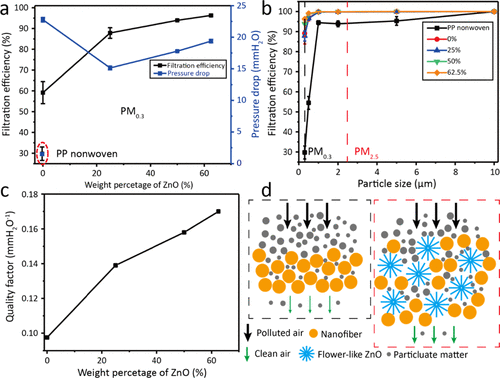
Figure 5. (a) Filtration efficiency and pressure drop of ZnO@NF hybrid air filters versus the weight percentage of flower-like ZnO, (b) filtration efficiency of ZnO@NF hybrid air filters versus the particle size of NaCl aerosols, (c) quality factor of ZnO@NF hybrid air filters, and (d) schematic diagram to illustrate the polluted air pass through the pure nanofiber air filter and the ZnO@NF hybrid air filter.
In this work, we have successfully fabricated flower-like ZnO and the PVA-co-PE nanofiber hybrid membrane for the high-performance air filter. A template-free and surfactant-free hydrothermal strategy was used for the synthesis of monodisperse flower-like ZnO superstructures. The PVA-co-PE nanofiber yarns were obtained using the melt extrusion phase separation method. The flower-like ZnO superstructures were mixed with the PVA-co-PE nanofiber suspension and then coated on the surface of the PP meltblown nonwoven substrate with the elimination of electret charges to obtain the ZnO@NF hybrid air filter. Compared with the pure PVA-co-PE nanofiber air filter, the pressure drop of the ZnO@NF hybrid air filter was significantly decreased. It can be explained that the microsized flower-like ZnO superstructures were embedded in the PVA-co-PE nanofiber membrane, which acted as scaffolds to increase the porosity, specific surface area, and surface roughness, thereby reducing the air resistance across the air filter. The ZnO@NF hybrid air filters exhibit a much stable filtration efficiency than PP meltblown nonwoven, and thus, these ZnO@NF hybrid air filters have great potential for special applications such as high-temperature and high-humidity environments.
Poly(ethylene terephthalate) (PVA-co-PE) resin (ethylene content is 44 mol %) was purchased from Sigma-Aldrich (Milwaukee, WI). Cellulose acetate butyrate (CAB, buttery content 35–39%) was obtained from Eastman Chemical (Kingsport, TN). Isopropyl alcohol (IPA), zinc acetate dihydrate (Zn(CH3COO)2·2H2O), and sodium hydroxide (NaOH) were purchased from Sinopharm Chemical Reagent Co., Ltd. The 20 g/m2 meltblown nonwoven substrate was obtained from Handan Hengyong Protective Cleaning Supplies Co., Ltd.
The fabrication of PVA-co-PE nanofiber yarns was prepared by using the melt extrusion phase separation method according to the previous method reported in the literature published by our group. (35,36) The PVA-co-PE and CAB resin were dried in a vacuum oven at 85 °C for 4 h to remove moisture and mixed in a mass ratio of 20:80, and then directly fed into a Leistritz corotating twin-screw extruder (Model MIC 18/GL 30D, Nurnberg, Germany). The specific experiment parameters are set as follows: the feed rate is 12 g/min, the screw speed is 40 rpm, the draw ratio is 25, and the barrel temperature is set to 120, 150, 185, 195, 205, and 210 °C, respectively. To obtain PVA-co-PE nanofiber yarns, acetone was used to remove the CAB matrix. The 2 wt % PVA-co-PE nanofiber yarns were dispersed in an aqueous mixture of isopropanol and deionized water at a mass ratio of 60:40, and then, a stable nanofiber suspension was formed under high-speed shear.
The flower-like zinc oxide (ZnO) superstructures were synthesized using a template-free and surfactant-free hydrothermal method reported in the previously published literature. (30,32) The precursor solution was prepared by adding 0.9 M NaOH (30 mL) to 0.07 M Zn(CH3COO)2·2H2O (30 mL) under vigorous stirring. With the addition of NaOH solution, the precursor solution became turbid and then changed to clear because of excess NaOH. After 5 min, the precursor solution was transferred to a 100 mL Teflon-lined stainless steel autoclave, and the reaction was continued at 70 °C for 24 h. The reactant was washed three times with ethanol, followed by washing three times with deionized water. After drying at 60 °C for 10 h, the flower-like ZnO superstructure powder was obtained.
The flower-like ZnO superstructures with a weight percentage of 0, 25, 50, and 62.5% were added to a 2 wt % PVA-co-PE nanofiber suspension and then mixed with ultrasonication to form a nanofiber hybrid suspension. The nanofiber hybrid suspension was coated onto PP meltblown nonwoven treated with isopropanol for 6 h to eliminate the electret charge. The ZnO@NF hybrid air filter was obtained after drying in a fume hood for 12 h.
The structure and surface morphology of the prepared nanofiber hybrid air filters and flower-like ZnO superstructures were investigated by SEM (JSM IT1300A, JEOL, Japan). The diameter and size distribution of PVA-co-PE nanofibers were measured from SEM images by using Adobe Photoshop software. The flower-like ZnO XRD pattern was analyzed using an XRD system (X’pert PRO, PANalytical, Almelo, The Netherlands) with a Cu Ka radiation source (λ = 0.1544 nm), and the pattern was recorded in the range of 10–80° with a step size of 0.0260 degrees at a scan rate of 10 degrees per minute.
The filtration performance of ZnO@NF hybrid air filters, including the filtration efficiency, the pressure drop, and the quality factor, was investigated using an automatic filter tester (LZC-H, Suzhou Huada Instrument Equipment Co., Ltd., China). Monodisperse sodium chloride (NaCl) aerosols with the particle size in the range 0.3–10 μm were generated using an atomization air pump at a temperature of 25 °C and humidity of 50%, and the amount of NaCl aerosols was monitored using a laser particle counter. The experiments were performed at an airflow rate of 16 L/min and an effective test area of 50cm2.
The filtration efficiency (η) can be calculated using the following equation: (37−39)

(1)The quality factor (QF) was measured using the following equation: (6,14,37,39,40)

(2)where Cdown and Cup represent the amounts of NaCl aerosols in the downstream and upstream, respectively. ΔP is the pressure drop of NaCl aerosols passing through the
Article Source:
https://pubs.acs.org/doi/10.1021/acsomega.1c06114